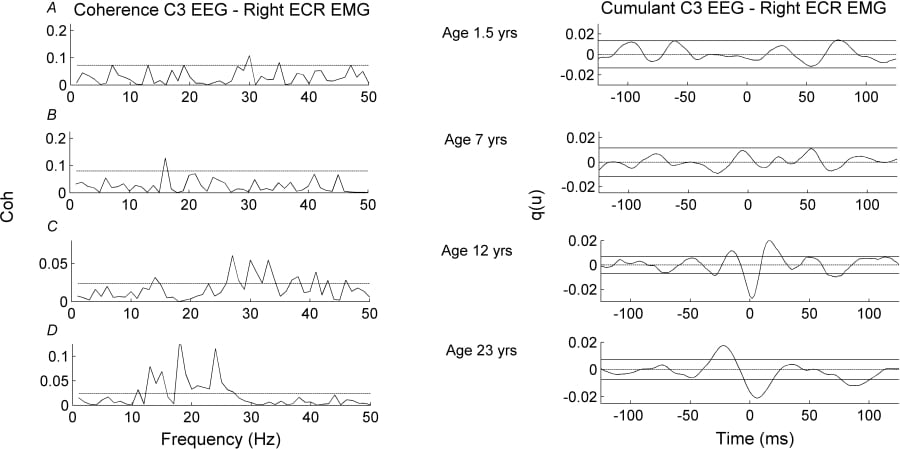In adult humans, coherence and cumulant analysis of the Electroencephalogram (EEG) and Electromyogram (EMG) shows that frequency components within the scalp EEG and contralateral EMG are coupled at approximately 20 Hz, during the performance of motor tasks requiring voluntary isometric muscle contraction (Halliday et al., 1998). Analysis of EMG recordings between steadily co-contracting synergistic hand muscles shows that there is significant coupling at ~20Hz frequencies. This EMG-EMG coupling has been attributed to central nervous system oscillatory drive and it has been shown to have a developmental profile with increasing levels as subjects reach adolescence (Farmer et al., 2007). Beta (~20 Hz) frequencies in the EEG increase around the time of adolescence (Gasser et al., 1988). Given this latter finding it is of interest to know whether the direct interaction between rhythmical elements comprising the EEG over the motor cortex and the contralateral EMG might also change with increasing age. With ethical approval, simultaneous recordings of EEG and rectified surface EMG recordings from forearm extensor muscles were obtained from 48 subjects aged between 0-59 years during a sustained right wrist extension motor task. The techniques of EEG-EMG coherence and cumulant analysis (Halliday et al., 1998) and pooled coherence and cumulant analysis (Amjad et al., 1997) were used to analyze the EEG and EMG signals. Data collected from different age groups were compared. Subjects within age groups 0-3 years and 4-10 years did not demonstrate both significant (P<0.05) coherence and cumulant. Within the age range of 12-17 years 30% of the subjects demonstrated both signficant (P<0.05) coherence and cumulant between left motor cortex EEG and right arm EMG. For Adults within the age range 19-55 years, 46% of subjects showed both significant (P<0.05) coherence and cumulant between left motor cortex EEG and right arm EMG. Comparisons made using a chi squared test across all four age groupings showed significant differences between children under the age of 10 years and the adult subjects (P = 0.036). These results demonstrate a significant effect of age on corticospinal oscillatory interaction as measured by EEG-EMG coherence and cumulant density estimates. The results show for the first time that changes in the cortical ~ 20 Hz oscillatory drive to human motoneurone pools take place during motor development in man. The relatively late emergence of ~20 Hz EEG-EMG coherence in humans, may reflect an important developmental change in the central nervous system, with implications for central nervous system plasticity and motor control.
University of Cambridge (2008) Proc Physiol Soc 11, C79
Oral Communications: Cortex-muscle oscillatory interactions show a developmental profile in humans.
L. M. James2,3, J. A. Stephens3, D. M. Halliday4, S. F. Farmer1,2
1. Department of Neurology, Institute of Neurology, London, United Kingdom. 2. Department of Clinical Neurophysiology, Imperial College Healthcare NHS Trust, London, United Kingdom. 3. Department of Physiology, University College London, London, United Kingdom. 4. Department of Electronics, University of York, York, United Kingdom.
View other abstracts by:
Coherence and cumulant between left motor cortex EEG and right forarm extensor EMG in 4 subjects of different ages. The data show the emergence in the older subjects of ~20 Hz coherence with associated triphasic cumulant.
Where applicable, experiments conform with Society ethical requirements.

